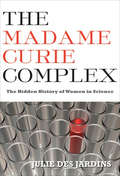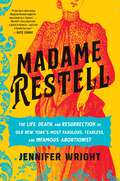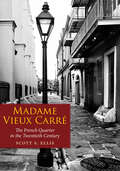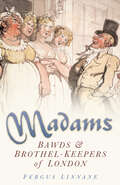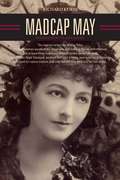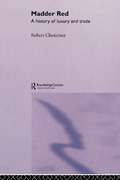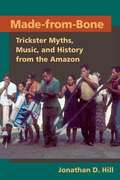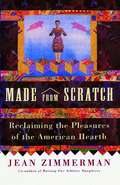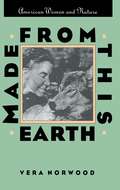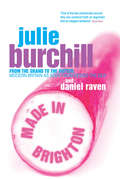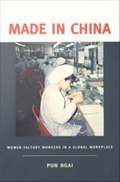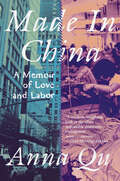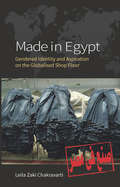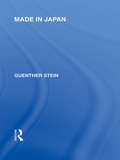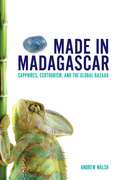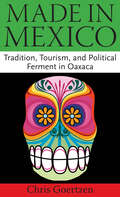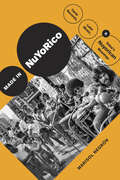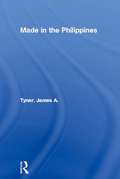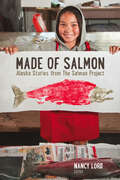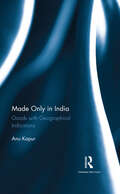- Table View
- List View
The Madame Curie Complex: The Hidden History of Women in Science (Women Writing Science Ser.)
by Julie Des JardinsThe historian and author of Lillian Gilbreth examines the &“Great Man&” myth of science with profiles of women scientists from Marie Curie to Jane Goodall. Why is science still considered to be predominantly male profession? In The Madame Curie Complex, Julie Des Jardin dismantles the myth of the lone male genius, reframing the history of science with revelations about women&’s substantial contributions to the field. She explores the lives of some of the most famous female scientists, including Jane Goodall, the eminent primatologist; Rosalind Franklin, the chemist whose work anticipated the discovery of DNA&’s structure; Rosalyn Yalow, the Nobel Prize-winning physicist; and, of course, Marie Curie, the Nobel Prize-winning pioneer whose towering, mythical status has both empowered and stigmatized future generations of women considering a life in science. With lively anecdotes and vivid detail, The Madame Curie Complex reveals how women scientists have changed the course of science—and the role of the scientist—throughout the twentieth century. They often asked different questions, used different methods, and came up with different, groundbreaking explanations for phenomena in the natural world.
Madame Restell: The Life, Death, and Resurrection of Old New York's Most Fabulous, Fearless, and Infamous Abortionist
by Jennifer Wright**Longlisted for the Brooklyn Public Library Book Prize in Nonfiction (2023)** **An Amazon EDITOR'S PICK for BEST BOOKS OF 2023 SO FAR in BIOGRAPHY/MEMOIR and HISTORY** **An Amazon EDITOR'S PICK for BEST BOOKS OF THE MONTH (March 2023)** **A Bookshop.Org EDITOR'S PICK (March 2023)** &“This is the story of one of the boldest women in American history: self-made millionaire, a celebrity in her era, a woman beloved by her patients and despised by the men who wanted to control them.&” An industrious immigrant who built her business from the ground up, Madame Restell was a self-taught surgeon on the cutting edge of healthcare in pre-Gilded Age New York, and her bustling &“boarding house&” provided birth control, abortions, and medical assistance to thousands of women—rich and poor alike. As her practice expanded, her notoriety swelled, and Restell established her-self as a prime target for tabloids, threats, and lawsuits galore. But far from fading into the background, she defiantly flaunted her wealth, parading across the city in designer clothes, expensive jewelry, and bejeweled carriages, rubbing her success in the faces of the many politicians, publishers, fellow physicians, and religious figures determined to bring her down. Unfortunately for Madame Restell, her rise to the top of her field coincided with &“the greatest scam you&’ve never heard about&”—the campaign to curtail women&’s power by restricting their access to both healthcare and careers of their own. Powerful, secular men—threatened by women&’s burgeoning independence—were eager to declare abortion sinful, a position endorsed by newly-minted male MDs who longed to edge out their feminine competition and turn medicine into a standardized, male-only practice. By unraveling the misogynistic and misleading lies that put women&’s lives in jeopardy, Wright simultaneously restores Restell to her rightful place in history and obliterates the faulty reasoning underlying the very foundation of what has since been dubbed the &“pro-life&” movement. Thought-provoking, character-driven, boldly written, and feminist as hell, Madame Restell is required reading for anyone and everyone who believes that when it comes to women&’s rights, women&’s bodies, and women&’s history, women should have the last word.
Madame Vieux Carre: The French Quarter in the Twentieth Century
by Scott S. EllisCelebrated in media and myth, New Orleans's French Quarter (Vieux Carré) was the original settlement of what became the city of New Orleans. In Madame Vieux Carré, Scott S. Ellis presents the social and political history of this famous district as it evolved from 1900 through the beginning of the twenty-first century. From the immigrants of the 1910s, to the preservationists of the 1930s, to the nightclub workers and owners of the 1950s and the urban revivalists of the 1990s, Madame Vieux Carré examines the many different people who have called the Quarter home, who have defined its character, and who have fought to keep it from being overwhelmed by tourism's neon and kitsch. The old French village took on different roles—bastion of the French Creoles, Italian immigrant slum, honky-tonk enclave, literary incubator, working-class community, and tourist playground. The Quarter has been a place of refuge for various groups before they became mainstream Americans. Although the Vieux Carré has been marketed as a free-wheeling, boozy tourist concept, it exists on many levels for many groups, some with competing agendas. Madame Vieux Carré looks, with unromanticized frankness, at these groups, their intentions, and the future of the South's most historic and famous neighborhood. The author, a former Quarter resident, combines five years of research, personal experience, and unique interviews to weave an eminently readable history of one of America's favorite neighborhoods.
Madams: Bawds and Brothel-Keepers of London
by Fergus LinnaneAt a time when there were almost no career opening for women, a group of intrepid and gifted females scaled the heights of what was literally a man's world - they became brothelkeepers, or 'bawds', Mother Clap - women bawds were often known as Mother - ran male brothels, or Molly Houses. Elizabeth Holland had an immense moated mansion built on Bankside and for 30 years entertained the aristocracy, including royalty. When troops attempted to stop her trade and eject her from the house, she and her girls drove them off. The Georgian bawd Charlotte Hayes held a 'Cyprian Fete' at which gentlemen "of the highest breeding" first watched athletic young men copulating with nubile whores and then joined in themselves. Fergus Linnane reveals the other side of London's years of pomp and splendour, painting a vivid picture of the bawds, their girls, and their clients. Madams is fresh and original, offering humour, insight, and a very candid view of the sexual behaviour of Londoners through the ages.
Madcap May: Mistress of Myth, Men, and Hope
by Richard KurinMay Yohe was a popular entertainer from humble American origins who married and then abandoned a wealthy English Lord who owned the fabled Hope diamond--one of the most valuable objects in the world and now exhibited at the Smithsonian Institution in Washington, D.C. May was a romantic who had numerous lovers and at least three husbands--though the tabloids rumored twelve. One included the playboy son of the Mayor of New York. May separated from him--twice--and cared for her next husband, a South African war hero and invalid whom she later shot.Crossing the paths of Ethel Barrymore, Boris Karloff, Oscar Hammerstein, Teddy Roosevelt, Consuelo Vanderbilt, and the Prince of Wales, May Yohe was a foul-mouthed, sweet-voiced showgirl who drew both the praise and rebuke of Nobel laureate George Bernard Shaw. Nicknamed "Madcap May," she was a favorite of the press. In later years she faced several maternity claims and a law suit which she won. She was hospitalized in an insane asylum and escaped. She ran a rubber plantation in Singapore, a hotel in New Hampshire, and a chicken farm in Los Angeles. When all else failed, she washed floors in a Seattle shipyard, and during the Depression held a job as a government clerk. Shortly before her death, she fought, successfully, to regain her lost U.S. citizenship.How was this woman, May Yohe, able to charm her way to international repute, live an impossible life, and also find the strength to persevere in light of the losses she suffered--in wealth, citizenship, love, and sanity? Madcap May, assembled from her writings and historical interviews, archival records, newspaper stories, scrapbooks, photographs, playbills, theatrical reviews, souvenirs, and silent film, tells her heretofore lost story.
Madder Red: A History of Luxury and Trade (Caucasus World)
by Robert ChencinerMadder red is an ancient dyestuff, extracted from the root of the madder plant, growing in many countries around the world. The secret and devilishly complex Oriental dyeing process to obtain the lustrous colour known as Turkey Red was avidly sought by Europeans, from the time before the fall of Ancient Rome. It was finally cracked by the French about 1760, who were able to dye wool, silk and cotton bright red. After the lowlands of the Caspian Caucasus had been subdued by the Russians in the early 1800s, madder was cultivated there and rapidly became the main crop. The quest for Turkey Red went hand in hand with an avalanche of scientific research, which not only improved the yield of dyestuff from the roots but led to its chemical synthesis and in 1870 the collapse of the world-wide madder industry. Many of the nascent dye companies grew into chemical giants of our time. Further regional and cultural background may be found in Chenciner's Daghestan: Tradition and Survival, also published in the Caucasus World series.
Made from Bone: Trickster Myths, Music, and History from the Amazon
by Jonathan D. HillMade-from-Bone provides the first complete set of English translations of narratives about the mythic past and its transformations from the indigenous Arawak-speaking Wakuénai of southernmost Venezuela. The central character throughout these primordial times is a trickster-creator, Made-from-Bone, who survives a prolonged series of life-threatening attacks. Carefully recorded and transcribed by Jonathan D. Hill, these narratives offer scholars of South America and other areas the only ethnographically generated cosmogony of contemporary or ancient native peoples of South America.
Made from Scratch: Reclaiming the Pleasures of the American Hearth
by Jean ZimmermanA stunning celebration and reappraisal of the importance of "women's work," Made from Scratch addresses the tug that many Americans feel between our professional and private lives. In this stunning celebration and reappraisal of the importance of "women's work," acclaimed journalist Jean Zimmerman poignantly addresses the tug that many Americans of the twenty-first century feel between our professional and private lives. With sharp wit and intelligence, she offers evidence that in the current domestic vacuum, we still long for a richer home life -- a paradox visible in the Martha Stewart phenomenon, in the continuing popularity of women's service magazines such as Better Homes and Gardens, Family Circle, and Ladies' Home Journal -- whose combined circulation of over 17 million is nearly twice the combined circulation of Time, Newsweek, and U.S. News & World Report -- and the booming business of restorations, where onlookers get a hands-on view of domestic life as it flourished in past centuries. This book is about the ways home traditions passed from one generation to the next -- baking a birthday cake from scratch, cherishing family heirlooms, or discovering the satisfaction of piecing a quilt -- sustain our souls, especially in our ever more processed, synthetic world, where we buy "homemade" goods and fail to see the irony in that.Made from Scratch tells the story of the unsung heroines of the hearth, investigating the history of female domesticity and charting its cultural changes over centuries. Zimmerman traces the lives of her own family's homemakers -- from her tiny but indomitable grandmother, who managed a farm, strangled chickens with her bare hands, and sewed all the family clothing, to her mother, who rejected her country upbringing yet kept a fastidious suburban home where the gender divide stayed firmly in place, to her own experiences as a wife and mother weaned on the Women's Movement of the 1970s, with its emphatic view that housework was a dirty word and that the domestic sphere was to be fled rather than cherished. In this book Zimmerman questions the unexamined trade-off we have made in a shockingly brief time span, as we've "progressed" from home-raised chickens to frozen TV dinners to McNuggets from the food court at the mall. What is lost when we no longer engage, as individuals and as a community, in the ancient rituals of food, craft, and shelter?
Made from Scratch
by Jean ZimmermanIn this stunning celebration and reappraisal of the importance of "women's work," acclaimed journalist Jean Zimmerman poignantly addresses the tug that many Americans of the twenty-first century feel between our professional and private lives. With sharp wit and intelligence, she offers evidence that in the current domestic vacuum, we still long for a richer home life -- a paradox visible in the Martha Stewart phenomenon, in the continuing popularity of women's service magazines such as Better Homes and Gardens, Family Circle, and Ladies' Home Journal -- whose combined circulation of over 17 million is nearly twice the combined circulation of Time, Newsweek, and U.S. News & World Report -- and the booming business of restorations, where onlookers get a hands-on view of domestic life as it flourished in past centuries. This book is about the ways home traditions passed from one generation to the next -- baking a birthday cake from scratch, cherishing family heirlooms, or discovering the satisfaction of piecing a quilt -- sustain our souls, especially in our ever more processed, synthetic world, where we buy "homemade" goods and fail to see the irony in that.Made from Scratch tells the story of the unsung heroines of the hearth, investigating the history of female domesticity and charting its cultural changes over centuries. Zimmerman traces the lives of her own family's homemakers -- from her tiny but indomitable grandmother, who managed a farm, strangled chickens with her bare hands, and sewed all the family clothing, to her mother, who rejected her country upbringing yet kept a fastidious suburban home where the gender divide stayed firmly in place, to her own experiences as a wife and mother weaned on the Women's Movement of the 1970s, with its emphatic view that housework was a dirty word and that the domestic sphere was to be fled rather than cherished. In this book Zimmerman questions the unexamined trade-off we have made in a shockingly brief time span, as we've "progressed" from home-raised chickens to frozen TV dinners to McNuggets from the food court at the mall. What is lost when we no longer engage, as individuals and as a community, in the ancient rituals of food, craft, and shelter?
Made From This Earth
by Vera NorwoodThe broad sweep of environmental and ecological history has until now been written and understood in predominantly male terms. In Made From This Earth, Vera Norwood explores the relationship of women to the natural environment through the work of writers, illustrators, landscape and garden designers, ornithologists, botanists, biologists, and conservationists.Norwood begins by showing that the study and promotion of botany was an activity deemed appropriate for women in the early 1800s. After highlighting the work of nineteenth-century scientific illustrators and garden designers, she focuses on nature's advocates such as Rachel Carson and Dian Fossey who differed strongly with men on both women's "nature" and the value of the natural world. These women challenged the dominant, male-controlled ideologies, often framing their critique with reference to values arising from the female experience. Norwood concludes with an analysis of the utopian solutions posed by ecofeminists, the most recent group of women to contest men over the meaning and value of nature.
Made in America: A Social History of American Culture and Character
by Claude S. FischerOur nation began with the simple phrase, "We the People." But who were and are "We"? Who were we in 1776, in 1865, or 1968, and is there any continuity in character between the we of those years and the nearly 300 million people living in the radically different America of today? With Made in America, Claude S. Fischer draws on decades of historical, psychological, and social research to answer that question by tracking the evolution of American character and culture over three centuries. He explodes myths-such as that contemporary Americans are more mobile and less religious than their ancestors, or that they are more focused on money and consumption-and reveals instead how greater security and wealth have only reinforced the independence, egalitarianism, and commitment to community that characterized our people from the earliest years. Skillfully drawing on personal stories of representative Americans, Fischer shows that affluence and social progress have allowed more people to participate fully in cultural and political life, thus broadening the category of "American" -yet at the same time what it means to be an American has retained surprising continuity with much earlier notions of American character. Firmly in the vein of such classics as The Lonely Crowd and Habits of the Heart--yet challenging many of their conclusions--Made in America takes readers beyond the simplicity of headlines and the actions of elites to show us the lives, aspirations, and emotions of ordinary Americans, from the settling of the colonies to the settling of the suburbs.
Made in Baja: The Lives of Farmworkers and Growers behind Mexico's Transnational Agricultural Boom
by Christian ZlolniskiMuch of the produce that Americans eat is grown in the Mexican state of Baja California, the site of a multibillion-dollar export agricultural boom that has generated jobs and purportedly reduced poverty and labor migration to the United States. But how has this growth affected those living in Baja? Based on a decade of ethnographic fieldwork, Made in Baja examines the unforeseen consequences for residents in the region of San Quintín. The ramifications include the tripling of the region’s population, mushrooming precarious colonia communities lacking basic infrastructure and services, and turbulent struggles for labor, civic, and political rights. Anthropologist Christian Zlolniski reveals the outcomes of growers structuring the industry around an insatiable demand for fresh fruits and vegetables. He also investigates the ecological damage—"watercide”—and the social side effects of exploiting natural resources for agricultural production. Weaving together stories from both farmworkers and growers, Made in Baja provides an eye-opening look at the dynamic economy developing south of the border.
Made In Brighton: From the grand to the gutter: Modern Britain as seen from beside the sea
by Daniel Raven Julie BurchillBritain is experiencing a sudden reckless rush of liberalisation, from 24 hour licensing to gay marriages. But how did we get from idolising Grace Kelly and Prince Rainier to Jordan and Peter Andre? Funny and bittersweet, Made In Brighton interweaves personal stories of life in Brighton with larger themes of sex, politics and class to take a cold, hard look at the changing face of Britain, and at the town which has always been at the vanguard of Britain's cultural evolution. From punk to dance, dope to coke, the Labour party to hen parties, straight to gay to bi, this book holds a mirror up to the dazed face of Britain and gives it a good hard slap.
Made In China: Women Factory Workers In a Global Workplace
by Pun NgaiAs China has evolved into an industrial powerhouse over the past two decades, a new class of workers has developed: the dagongmei, or working girls. The dagongmei are women in their late teens and early twenties who move from rural areas to urban centers to work in factories. Because of state laws dictating that those born in the countryside cannot permanently leave their villages, and familial pressure for young women to marry by their late twenties, the dagongmei are transient labor. They undertake physically exhausting work in urban factories for an average of four or five years before returning home. The young women are not coerced to work in the factories; they know about the twelve-hour shifts and the hardships of industrial labor. Yet they are still eager to leave home. Made in China is a compelling look at the lives of these women, workers caught between the competing demands of global capitalism, the socialist state, and the patriarchal family. Pun Ngai conducted ethnographic work at an electronics factory in southern China's Guangdong province, in the Shenzhen special economic zone where foreign-owned factories are proliferating. For eight months she slept in the employee dormitories and worked on the shop floor alongside the women whose lives she chronicles. Pun illuminates the workers' perspectives and experiences, describing the lure of consumer desire and especially the minutiae of factory life. She looks at acts of resistance and transgression in the workplace, positing that the chronic pains--such as backaches and headaches--that many of the women experience are as indicative of resistance to oppressive working conditions as they are of defeat. Pun suggests that a silent social revolution is underway in China and that these young migrant workers are its agents.
Made in China: A Memoir of Love and Labor
by Anna QuA young girl forced to work in a Queens sweatshop calls child services on her mother in this powerful debut memoir about labor and self-worth that traces a Chinese immigrant's journey to an American future. <p><p> As a teen, Anna Qu is sent by her mother to work in her family's garment factory in Queens. At home, she is treated as a maid and suffers punishment for doing her homework at night. Her mother wants to teach her a lesson: she is Chinese, not American, and such is their tough path in their new country. But instead of acquiescing, Qu alerts the Office of Children and Family Services, an act with consequences that impact the rest of her life. Nearly twenty years later, estranged from her mother and working at a Manhattan start-up, Qu requests her OCFS report. When it arrives, key details are wrong. <p><p> Faced with this false narrative, and on the brink of losing her job as the once-shiny start-up collapses, Qu looks once more at her life's truths, from abandonment to an abusive family to seeking dignity and meaning in work. Traveling from Wenzhou to Xi'an to New York, Made in China is a fierce memoir unafraid to ask thorny questions about trauma and survival in immigrant families, the meaning of work, and the costs of immigration.
Made In Egypt: Gendered Identity and Aspiration on the Globalised Shop Floor
by Leila Zaki ChakravartiThis ground-breaking ethnography of an export-orientated garment assembly factory in Egypt examines the dynamic relationships between its managers - emergent Mubarak-bizniz (business) elites who are caught in an intensely competitive globalised supply chain - and the local daily-life realities of their young, educated, and mixed-gender labour force. Constructions of power and resistance, as well as individual aspirations and identities, are explored through articulations of class, gender and religion in both management discourses and shop floor practices. Leila Chakravarti's compelling study also moves beyond the confines of the factory, examining the interplay with the wider world around it.
Made in Japan (Routledge Library Editions: Japan)
by Guenther SteinThis volume concentrates on the effect of Japanese trade competition on the UK and Europe, it also provides an illuminating picture of political, social and military conditions in Japan in the early twentieth century.
Made in Japan and Other Japanese Business Novels
by Tamae K. PrindleThe term "business novel" is a translation of the Japanese word kezai shosetsu, which may be translated literally as * 'economy novel.'' Critic Makoto Sataka first used the word "business" in place of "economy" in his monograph How to Read Business Novels (1980).l Business novels are "popular novels" (taishu bungaku) widely read by Japanese businessmen, their wives, students, and other professionals.. Business novels were recognized as a * 'field'' or a literary sub-genre in the late 1950s. It was Saburo Shiroyama's Export (Yushutsu) (1957), if not his Kinjo the Corporate Bouncer (Sokaiya Kinjo) (1959), which marshalled their enormous popularity. The seven short works in this collection represent prototypes of the business novel. Their distinctive features are that business activities motivate plot developments, although psycho-socio-cultural elements are tightly interwoven.
Made in Madagascar: Sapphires, Ecotourism, And The Global Bazaar (Teaching Culture: Utp Ethnographies For The Classroom Ser.)
by Andrew WalshSince the 1990s, the Ankarana region of northern Madagascar has developed a reputation among globe-trotting gemstone traders and tourists as a source of some of the world's most precious natural wonders. Although some might see Ankarana's sapphire and ecotourist trades as being at odds with each other, many local people understand these trades to be fundamentally connected, most obviously in how both serve foreign demand for what Madagascar has to offer the world. Walsh explores the tensions and speculations that have come with the parallel emergence of these two trades with sensitivity and a critical eye, allowing for insights into globalization, inequality, and the appeal of the "natural." For more information, and to read a hyperlinked version of the first chapter online, visit www.madeinmadagascar.org.
Made in Mexico: Tradition, Tourism, and Political Fermant in Oaxaca
by Chris GoertzenMade in Mexico examines the aesthetic, political, and sociopolitical aspects of tourism in southern Mexico, particularly in the state of Oaxaca. Tourists seeking "authenticity" buy crafts and festival tickets and spend even more on travel expenses. What does a craft object or a festival moment need to look like or sound like to please both tradition bearers and tourists in terms of aesthetics? Under what conditions are transactions between these parties psychologically healthy and sustainable? What political factors can interfere with the success of this negotiation, and what happens when the process breaks down? With Subcommandante Marcos and the Zapatistas still operating in neighboring Chiapas and unrest on the rise in Oaxaca itself, these are not merely theoretical problems. Chris Goertzen analyzes the nature and meaning of a single craft object, a woven pillowcase from Chiapas, thus previewing what the book will accomplish in greater depth in Oaxaca. He introduces the book's guiding concepts, especially concerning the types of aesthetic intensification that have replaced fading cultural contexts, and the tragic partnership between ethnic distinctiveness and oppressive politics. He then brings these concepts to bear on crafts in Oaxaca and on Oaxaca's Guelaguetza, the anchor for tourism in the state and a festival with an increasingly contested meaning.
Made in NuYoRico: Fania Records, Latin Music, and Salsa’s Nuyorican Meanings (Refiguring American Music)
by Marisol NegrónIn Made in NuYoRico, Marisol Negrón tells the cultural history of salsa, tracing the music’s Nuyorican meanings over a fifty-year period that begins with the establishment of Fania Records in 1964 and how it capitalized on salsa’s Nuyorican imaginary to cultivate a global audience. Drawing on interviews with fans, legendary musicians, and music industry figures as well as analyses of songs, albums, films, and archival documents, Negrón shows how Nuyorican cultural and social histories became embedded in and impacted salsa music's flows during its foundational period in the mid-1960s and its boom in the 1970s. Salsa’s Nuyorican aesthetics challenged mainstream notions of Americanness and Puerto Ricanness and produced an alternative public sphere through which New York’s poor and working-class Puerto Ricans could contest racialization and colonial power. By outlining salsa’s complicated musical, cultural, commercial, racial, gendered, legal, and political entanglements, Negrón demonstrates its centrality to Nuyorican identity and subjectivity.
Made in Scotland: Studies in Popular Music (Routledge Global Popular Music Series)
by Simon Frith Martin Cloonan John WilliamsonMade in Scotland: Studies in Popular Music serves as a comprehensive and thorough introduction to the history, politics, culture, and musicology of twentieth- and twenty-first-century popular music in Scotland. The volume consists of essays by local experts and leading scholars in Scottish music and culture, and covers the major figures, styles, and social contexts of popular music in Scotland. Each essay provides adequate context so readers understand why the figure or genre under discussion is of lasting significance. The book includes a general introduction to Scottish popular music, followed by essays organized into three thematic sections: Histories, Politics and Policies, and Futures and Imaginings. Examining music as cultural expression in a country that is both a nation and a region within a larger state, this volume uses popular music to analyse Scottishness, independence, and diversity and offers new insights into the complexity of cultural identity, the power of historical imagination, and the effects of power structures in music. It is a vital read for scholars and students interested in how popular music interacts with and shapes such issues both within and beyond the borders of Scotland.
Made in the Philippines (Routledge Pacific Rim Geographies #Vol. 5)
by James A. TynerThe Philippines is the world's largest exporter of temporary contract labor with a huge 800,000 workers a year being deployed on either six month or two year contracts. This labor migration is highly regulated by the government, private, and non-governmental/non-private organizations. Tyner argues that migrants are socially constructed, or 'made' by these parties and that migrants in turn become political resources. Employing a post-structural feminist perspective Tyner questions the very ontology of migration.
Made of Salmon: Alaska Stories from the Salmon Project
by Nancy LordAll over the world, salmon populations are in trouble, as overfishing and habitat loss have combined to put the once-great Atlantic and Pacific Northwest runs at serious risk. Alaska, however, stands out as a rare success story: its salmon populations remain strong and healthy, the result of years of careful management and conservation programs that are rooted in a shared understanding of the importance of the fish to the life, culture, and history of the state. Made of Salmon brings together more than fifty diverse Alaska voices to celebrate the salmon and its place in Alaska life. A mix of words and images, the book interweaves longer works by some of Alaska’s finest writers with shorter, more anecdotal accounts and stunning photographs of Alaskans fishing for, catching, preserving, and eating salmon throughout the state. A love letter to a fish that has been central to Alaska life for centuries, Made of Salmon is a reminder of the stakes of this great, ongoing conservation battle.
Made Only in India: Goods with Geographical Indications
by Anu KapurWhat makes Darjeeling tea, Pashmina shawl, Monsooned Malabar Arabica coffee and Chanderi saree special? Why is it that some goods derive their uniqueness through their inherent linkage to a place? In a pioneering study, this book explores this intriguing question in the Indian context across 199 registered goods with geographical indications, linked with their place of origin. It argues that the origin of these goods is attributed to a distinctive ecology that brews in a particular place. The attributes of their origin further endorse their unique geographical indications through legal channels. Drawing from a variety of disciplines including geography, history, sociology, handicrafts, paintings, and textiles, the author also examines the Geographical Indications Act of 1999, and shows how it has created a scope to identify, register and protect those goods, be they natural, agricultural, or manufactured. The work presents a new perspective on the indigenous diversities and offers an original understanding of the geography and history of India. Lucid and accessible, with several illustrative maps, this book will be useful to scholars and researchers in the social sciences, environmental studies, development studies, law, trade and history.
